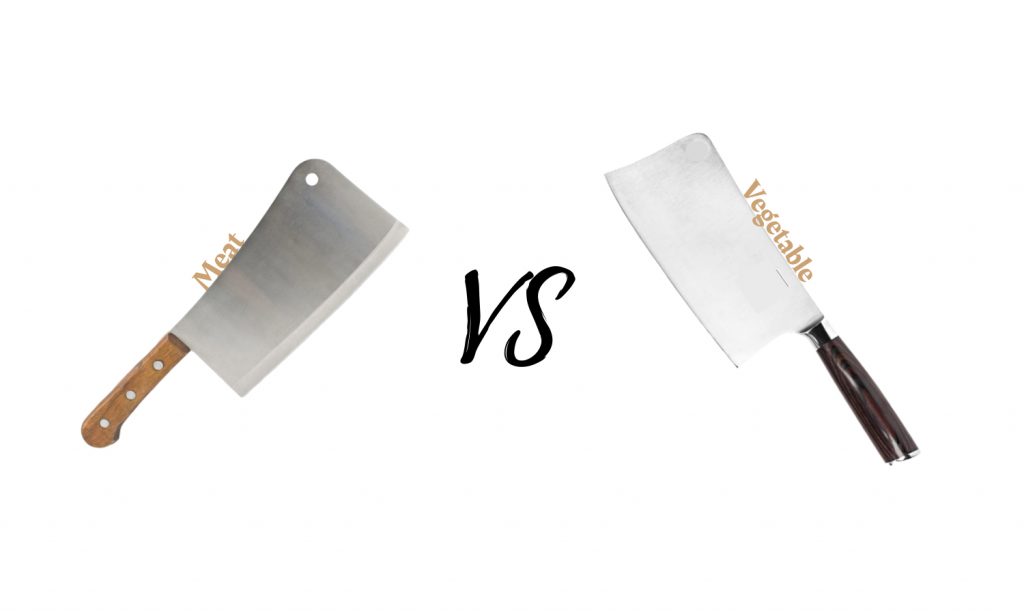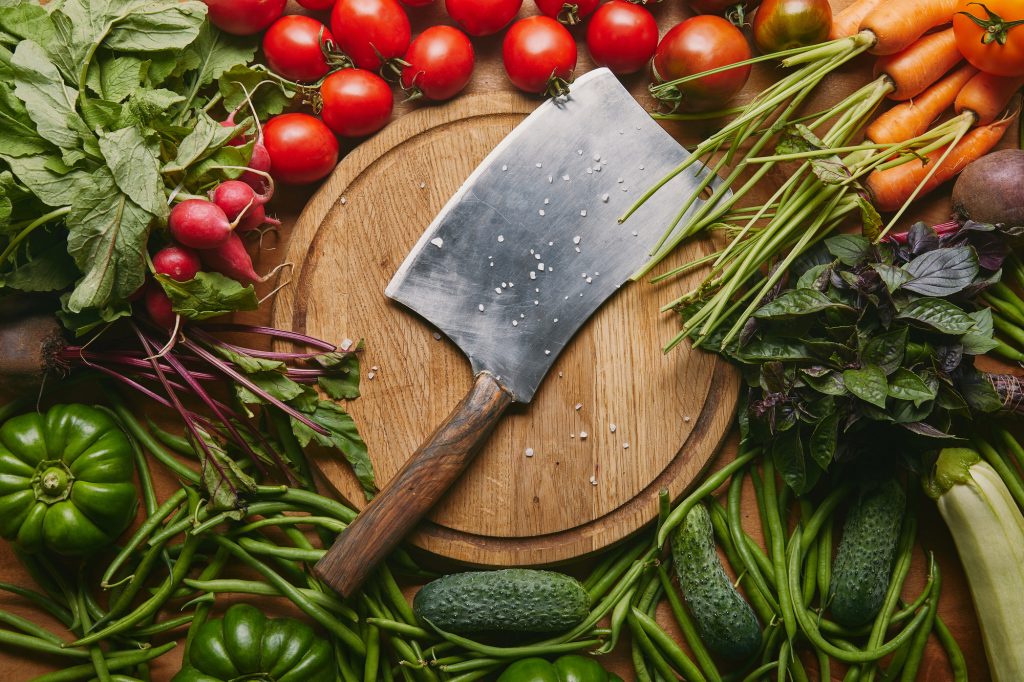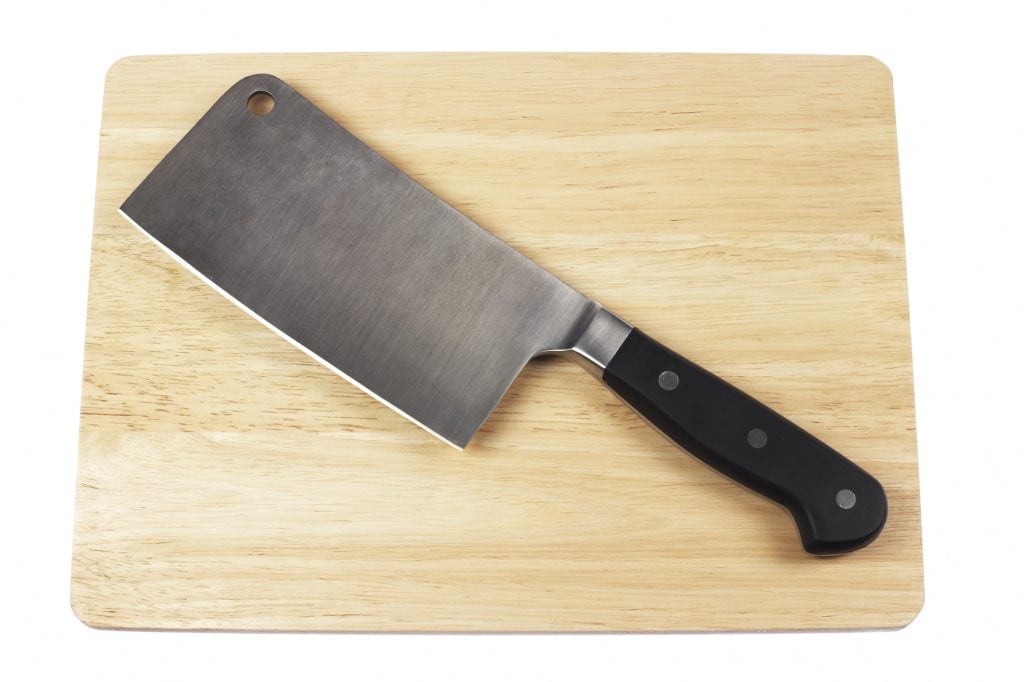Mastering your chef’s tools is the only way to grow sustainably as a cook. Before mastery is possible, you’ll need to understand the purpose of your equipment in intimate detail. In this article, we’ll explore the meat cleaver VS vegetable cleaver debate. What is each knife most suitable for and how can you tell when to use each? Read on to find out.

Meat Cleaver Basics
Meat cleavers have relatively thick, tough blades that are designed to handle some of the most challenging tasks in the kitchen. If you’re cutting bones or chopping super dense vegetables, a meat cleaver will serve you well.
Most feature an iconic hole that’s used for hanging and occasionally for extra grip when working. Most meat cleavers are fairly rigid with large, formidable blades.
Find out why meat cleavers have holes in them.
Meat Cleaver Uses:
- Cutting through dense cuts of meat
- Breaking/ cutting through the bones on the meat
- Disjointing and preparing larger meats
- Tackling very tough/ dense foods
Meat Cleaver Basic Stats:
- Usually a 7 or 8-inch blade
- Typically 1/4 to 3/16 inches thick (thicker can be stronger but thinner can slice more easily)
- Between 55 and 58 HRC
Vegetable Cleaver Basics
At first glance, a vegetable cleaver has a similar appearance to its meat-focused counterparts. On closer inspection, however, one soon learns that they serve very different purposes. This type of knife typically features a thinner blade for more delicate slicing.
As the name suggests, a vegetable cleaver is most often used to prepare softer veggies in the kitchen. More intricate work can be achieved with this kind of knife.
Vegetable Cleaver Uses:
- Slicing and preparing vegetables
- More intricate, delicate cuts
- Cutting previously deboned meats
- General prep work
Vegetable Cleaver Basic Stats:
- Blades between 6 and 8 inches
- Blade thickness from 1/32 to ⅓ of an inch
- Between 54 and 56 HRC (however, stats can vary)
Vegetable Cleaver VS Meat Cleaver – How They’re Different
In a nutshell:
Meat cleavers are thicker, tougher knives used primarily for hacking through bones and preparing denser foods.
Vegetable cleavers are thinner knives designed to slice and prep softer veggies and sometimes deboned meats.
Cleaver | Vegetable | Meat |
Blade Length | 6-8 inches | 7-8 inches |
Blade Thickness | Blade Thickness 1/32 to ⅓ of an inch | 1/4 to 3/16 of an inch |
Flexibility | Varies but more flexibility than a meat cleaver | Some but fairly rigid |
HRC | 54 and 56 | 55 – 58 |
Main Purpose | Slicing and preparing vegetables and more intricate tasks. | Hacking through bone and chopping dense foods. |
Thickness
If it’s thick, rigid, and tough, it’s probably a meat cleaver. More delicate tasks that need precise cuts won’t be possible. For this, the thinner blade of a vegetable cleaver will work best.
Flexibility
One thing to watch out for is that many vegetable and meat cleavers look quite similar. The main giveaways are weight and blade thickness.
Which One Should I Choose?
If you’re working in a kitchen that processes a lot of frozen or unprepared meats, you’ll need the robust strength of a meat cleaver to hack through all that bone and tissue.
For those who need a more general-purpose blade that’s great for veggies and more delicate prep work, a vegetable cleaver is a way to go.
Meat Cleaver Recommendation
Our absolute favorite meat cleaver in 2022 is this one – DALSTRONG Cleaver Knife – Phantom Series.
It strikes an excellent balance between performance, comfort, and affordability.
Find the best meat cleaver for your requirements.
Vegetable Cleaver Recommendation
Want a vegetable cleaver recommendation? We can’t stop raving about this one – Tuo Vegetable Chinese Cleaver.
The sharpness, balance, and price are all tough to beat.
Looking for the best vegetable cleaver in 2022?

Final Thoughts
We hope you’ve found our discussion on this page helpful. If it’s thick and heavy, it’s probably a meat cleaver for hacking through bone. If it’s thin and great at slicing veggies, you’re holding a vegetable cleaver!
Read now >> Chinese cleaver vs Chef knife
For more kitchen insights, check out the rest of the Knives Academy site.





Post Your Thoughts